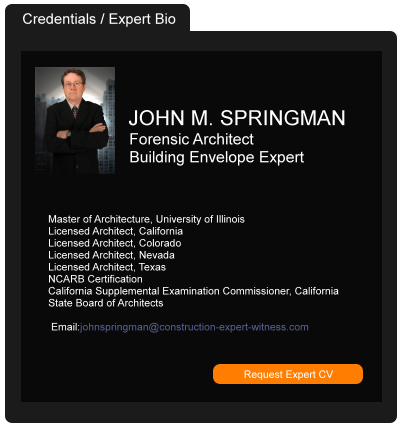Construction Defects in Roof May Close School
October 21, 2013 —
CDJ STAFFA school in Wales may have to close due to roof leaks. The school was opened six years ago, but since then the leaks at Ysgol Ffynnonbedr are “leading to the deterioration of the structure and fabric of the school.” The Lampeter city council have budgeted £35,000 (about $56,000) for repairs to the roof.
The leaks have already rendered some of the electrical systems and teaching areas unusable. The city council had been in discussion with the builders, Cowlin Construction, when that firm was bought by Balfour Beatty. Balfour Beatty did not comment to the Cambrian Times about resolving the construction defects.
Read the court decisionRead the full story...Reprinted courtesy of
Narrow House Has Wide Opposition
January 17, 2013 —
CDJ STAFFA small building project on Staten Island is causing some big complaints. While many residents of the area are still dealing with the aftermath of Hurricane Sandy, residents in the Port Richmond neighborhood are concerned about a house that is being built on a lot that at its widest is only seventeen feet. On the other end, the lot is only eleven feet wide.
Initially, the Staten Island did not give permission to build on the Orange Avenue lot, but the developer went to the city’s Board of Standards and Appeals who gave permission.
The daughter of one neighbor described the foundation as looking “like a swimming pool, not a house.” Her mother’s house has a 40-foot frontage. Another neighbor (37-foot frontage) described the plans to build the narrow house as “pretty stupid.”
Work currently stopped on the building over complaints that the site’s fence was incomplete. After the developer repairs the fence, the site needs to be inspected before work continues.
Read the court decisionRead the full story...Reprinted courtesy of
North Carolina Supreme Court Addresses “Trigger of Coverage,” Allocation and Exhaustion-Related Issues Arising Out of Benzene-Related Claims
January 04, 2023 —
White and Williams LLPOn December 16, 2022, the North Carolina Supreme Court decided Radiator Specialty Co. v. Arrowood Indem. Co., 2022 N.C. LEXIS 1122 (Dec. 16, 2022), in which it addressed coverage issues arising out of claims by individuals alleging injury from exposure to benzene contained in the insured’s products. Affirming in part and reversing in part the intermediate appellate court’s decision, the court held: (1) an “exposure trigger” applied; (2) defense and indemnity costs were subject to pro-rata allocation; and (3) vertical exhaustion applied to the duty to defend under certain umbrella policies. Two justices concurred in part and dissented in part.
I. Background
In Radiator Specialty, the insured (RSC) was named in hundreds of underlying suits arising from individual plaintiffs’ alleged exposure to benzene contained in its products. Between 1971 and 2012, RSC was insured under primary, umbrella and excess liability policies issued by various insurers. In 2013, RSC sued the insurers in North Carolina state court, seeking coverage for approximately $45 million in defense and indemnity costs incurred for the underlying claims. In 2016, the trial court decided motions for summary judgment on a number of coverage issues. Following a bench trial in 2018, the trial court entered final judgment, which required the insurers to reimburse $1.8 million of RSC’s past costs. The rulings were appealed to the North Carolina Court of Appeals, which issued a decision in 2020. In 2021, the North Carolina Supreme Court granted RSC’s and certain insurers’ petitions for discretionary review of the Court of Appeals’ decision.
Read the court decisionRead the full story...Reprinted courtesy of
White and Williams LLP
District Court's Ruling Affirmed in TCD v American Family Mutual Insurance Co.�
May 10, 2012 —
CDJ STAFFIn the case, TCD, Inc. v American Family Mutual Insurance Company, the district court’s summary judgment was in favor of the defendant. In response, the Plaintiff, TCD, appealed “on the ground that the insurance company had no duty to defend TCD under a commercial general liability (CGL) insurance policy.” The appeals court affirmed the decision.
�The appeals ruling provides a brief history of the case: “This case arises out of a construction project in Frisco, Colorado. The developer, Frisco Gateway Center, LLC (Gateway), entered into a contract with TCD, the general contractor, to construct a building. TCD entered into a subcontract with Petra Roofing and Remodeling Company (Petra) to install the roof on the building. The subcontract required Petra to "indemnify, hold harmless, and defend" TCD against claims arising out of or resulting from the performance of Petra’s work on the project. The subcontract also required Petra to name TCD as an additional insured on its CGL policy in connection with Petra’s work under the subcontract.”
�Furthermore, “TCD initiated this case against Petra and the insurance company, asserting claims for declaratory judgment, breach of insurance contract, breach of contract, and negligence. The district court entered a default judgment against Petra, and both the remaining parties moved for summary judgment. The court granted summary judgment on the entirety of the action, in favor of the insurance company, concluding that the counterclaims asserted by Gateway against TCD did not give rise to an obligation to defend or indemnify under the CGL policy.”
�The appeals court rejected each contention made by TCD in turn. First, “TCD contend[ed] that Gateway’s counterclaims constitute[d] an allegation of ‘property damage,’ which is covered under the CGL policy.” The appeals court disagreed. Next, “TCD argue[d] that [the court] should broaden or extend the complaint rule, also called the ‘four corners’ rule, and allow it to offer evidence outside of the counterclaims to determine the insurance company’s duty to defend in this case.” The appeals court was not persuaded by TCD’s argument.
�The judgment was affirmed. Judge Roman and Judge Miller concur.
�Read the court’s decision…
� Read the court decisionRead the full story...Reprinted courtesy of
The Importance of the Recent Amendment to Rule 702 of the Federal Rules of Evidence
January 22, 2024 —
Andrew G. Vicknair - The Dispute ResolverEvery litigator understands that expert witnesses play a key role in litigation, especially when dealing with construction issues. Expert testimony at trial can be a deciding factor in persuading a judge or jury in your client’s favor. It is so important that, as parties get closer to trial, litigators often spend considerable time filing motions to limit or disqualify certain aspects of expert testimony in an effort to gain an advantage at trial. Because experts are a key aspect of the trial process, it is important to understand the various rules governing use of expert testimony, primarily Rule 702 of the Federal Rules of Evidence.
On December 1, 2023, amendments to Rule 702 of the Federal Rules of Evidence went into effect which added the language in underline below and removed the language which is crossed out:
Rule 702. Testimony by Expert Witness
A witness who is qualified as an expert by knowledge, skill, experience, training, or education may testify in the form of an opinion or otherwise if the proponent demonstrates to the court that it is more likely than not that:
(a) the expert’s scientific, technical, or other specialized knowledge will help the trier of fact to understand the evidence or to determine a fact in issue;
(b) the testimony is based on sufficient facts or data;
(c) the testimony is the product of reliable principles and methods; and
(d) the expert has reliably applied expert’s opinion reflects a reliable application of the principles and methods to the facts of the case.
Read the court decisionRead the full story...Reprinted courtesy of
Andrew G. Vicknair, D'Arcy Vicknair, LLCMr. Vicknair may be contacted at
agv@darcyvicknair.com
NTSB Sheds Light on Fatal Baltimore Work Zone Crash
April 25, 2023 —
Justin Rice - Engineering News-RecordThe National Transportation Safety Board recently released conclusions of a preliminary investigation into a March 22
crash that killed six construction workers when an errant car sped through a work zone along the Interstate-695 Beltway in Baltimore.
Reprinted courtesy of
Justin Rice, Engineering News-Record
Mr. Rice may be contacted at ricej@enr.com
Read the full story... Read the court decisionRead the full story...Reprinted courtesy of
California’s Skilled and Trained Workforce Requirements: Public Works and AB 3018, What You Need to Know
December 09, 2019 —
Brenda Radmacher & Nicholas Krebs - Gordon & Rees Construction Law BlogDo you have the proper skilled and trained workforce for your construction projects? If you take on public works projects in California, you may not be in compliance with the new changes in the law. To avoid civil penalties or nonpayment and potentially being precluded from future bids on public works contracts, you must critically review your team and proposal prior to accepting an award. Once awarded a public contact requiring a skilled and trained workforce, diligent reporting practices and oversight are required to maintain compliance.
Compliance with California’s skilled and trained workforce requirements for contractors, engineers, architects, design professionals, and suppliers competing for public works construction projects in California is mandated through enforcement with the enactment of AB 3018. Signed by Governor Brown in his last legislative session, AB 3018 dramatically increased the penalties for non-compliance with the existing skilled and trained workforce requirements in California. The new penalties include civil fines by the Labor Commissioner up to $10,000 per month per non-compliant contractor, disqualification from bidding on future public works contract, and withholding of payment for delinquent contractors. This update provides information on California’s skilled and trained workforce requirements, identifies key issues on compliance to avoid penalties, and discusses the impact of enforcement on construction professionals’ business practices.
Reprinted courtesy of
Brenda Radmacher, Gordon & Rees Scully Mansukhani and
Nicholas Krebs, Gordon & Rees Scully Mansukhani
Ms. Radmacher may be contacted at bradmacher@grsm.com
Mr. Krebs may be contacted at nkrebs@grsm.com
Read the court decisionRead the full story...Reprinted courtesy of
Appellate Court reverses district court’s finding of alter ego in Sedgwick Properties Development Corporation v. Christopher Hinds (2019WL2865935)
August 13, 2019 —
Frank Ingham - Colorado Construction LitigationDivision V of the Colorado Court of Appeals addressed, for the first time, corporate veil-piercing in the context of a single-member, single-purpose LLC that is managed under a contract by another company. On July 3, 2019, the Court of Appeals reversed the order of the Honorable Ross B. Buchannan, Denver District Court Judge (17CA2102), who held that Plaintiff/Appellee Christopher Hinds satisfied the elements required to pierce the corporate veil of Sedgwick Properties Development Corporation (“Sedgwick”).
Background
Defendant 1950 Logan, LLC (“1950 Logan”) was the developer of a building located at 1950 Logan Street, in Denver, called The Tower on the Park (“Project”), which contained 141 individually owned condominium units. The Project was completed in 2006. 1950 Logan was a single-purpose entity created for the construction of the Project, which is a common practice in the construction industry. After the units were sold in 2006, the LLC wrapped up operations.
Read the court decisionRead the full story...Reprinted courtesy of
Frank Ingham, Higgins, Hopkins, McLain & Roswell, LLCMr. Ingham may be contacted at
ingham@hhmrlaw.com


































































